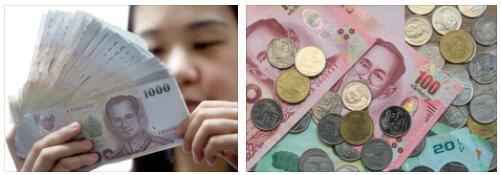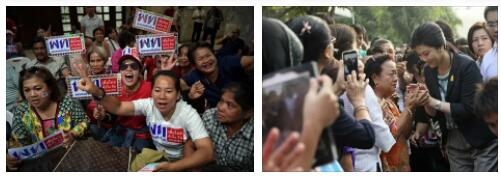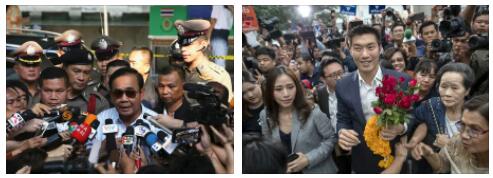Thailand Overview
Culturally influenced by Buddhism and rice cultivation, Thailand is now an up-and-coming industrial nation. Much is changing socially, culturally and politically. Marketed as the “Land of Smiles”, it has now become the land of political polarization between “yellow” and “red shirts”.
Country overview & natural area
Thailand is located on the Gulf of Thailand and the Andaman Sea. Mountains in the west and north of the country frame the great plain of the Chao Praya River, at the mouth of which lies the capital Bangkok. The extensive mountain ranges and beautiful coastlines attract over 25 million tourists to the country each year. But problems such as deforestation and industrial pollution threaten the country’s ecology.
History & State
Thailand’s turbulent history is marked by clashes between democratic and authoritarian forces. Since 2005 politics has been polarized between “yellow shirts” and “red shirts”. In 2014, the military staged a coup d’état against the elected government of Yingluck Shinawatra for the second time since 2006. After the 2019 elections, military chief Prayuth Chan-ocha was appointed prime minister.
Economy & Development
Thailand is an economically emerging country. The export-oriented industrialization in the boom years of the 80’s and 90’s created a lot of prosperity. But the rapid development also had its price. In 1997 there was a great economic crisis that shifted the balance of power in the economy and society. Social inequality is one reason for the social polarization of the country.
Society & culture
Society and culture are changing rapidly. Rural, traditional Thailand is disappearing in favor of new social groups and lifestyles. A committed cultural production in film, art and music emerges from the contradictions of social development.
Everyday & Practical Information
Official name: Kingdom of Thailand
Area: 513,115 km²
Residents: 69 million (2019)
Growth of population: 0.28% per year (2019)
Seat of government: Bangkok
Official language: Thai
Regional languages: Lao (northeast), Malay (south), Karen (west
Thailand is located in Southeast Asia on the Gulf of Thailand. To the west, Thailand shares a border with Myanmar, which is characterized by massive mountain ranges. To the east, Thailand borders Cambodia and Laos. In the north and northeast the border is formed by the Mekong. The elongated south borders on Malaysia. With an area of 513,000 km², the country is about one and a half times the size of Germany, but has about 14 million fewer residents.
Other useful maps are: a more detailed topographical and political map; an interactive road map; Satellite images of Thailand or Bangkok; a physical card; older maps showing vegetation and ethnic distribution; as well as thematic maps on demographics and economics and on humanitarian disasters.
Socio-geographical conditions
The social geography of Thailand is dominated by the omnipresence of the capital Bangkok. This is where the country’s economic and political power is particularly concentrated. Bangkok, with a population of 8-10 million, is classified as a megacity, while the next smaller cities – Nakhon Ratchasima (also called Khorat) and Khon Kaen in the northeast, Chiang Mai in the north or Hat Yai in the south are almost provincial. That is why many socio-geographical analyzes postulate an urban-rural contrast in which the elite would live in the city and the poor in the countryside. However, Bangkok is itself socio-geographically very different. The workers live in the industrial districts in the north and south-west and are closely linked with the rural areas in the north and north-east or even with Myanmar through circular migration.
In the meantime, the infrastructure of Thailand with roads and electricity is very well developed across the board. There are several international airports. The new Suvarnabhumi Airport in Bangkok was ranked tenth best in the world. The Yingluck government planned to expand the rail network with high-speed trains, but a constitutional court ruling halted the billion-dollar project. Since the coup in 2014, the plans have been further developed by the military government – this time without the intervention of the judges. Thailand is also well equipped with ports, of which Laem Chabang is one of the largest container ports in the world. Further major infrastructure projects are within the supported by the Asian Development Bank regional development in the Greater Mekong Subregion held, but sometimes in the criticisms are. The notorious traffic jams in the capital have eased somewhat since the construction of the Skytrain and the subway – although there is also a clear social gradient here – the ticket prices for these prestige objects are far too high for the poor.
Movie
In the performing arts, Thailand has a booming film industry alongside traditional dances and shadow theater, which is popular in the south. The Thai film industry has been experiencing a renaissance for several years. After the Asian crisis, many films made in Thailand became box office hits. A popular genre are period films such as Suriyothai, financed by Queen Sirikit, or King Naresuan, which glorify Siam and its struggle against Burma. Especially the martial arts films Ong Bak 1-3, Tom Yam Gung 1-2 or Born to Fighthave been successful beyond Thailand. These represent a romantic picture of an original, rural Thailand, which is conveyed through humble Muai Thai fighters who successfully defend themselves against foreign, corrupting influences. The strongly stereotypical gender roles conveyed in the Muai Thai films are also called into question by films like Beautiful Boxer, which traces the emotional journey of a transgender boxer. Independent cinema films are also successful, especially works by Apichatpong Weerasethakul, Pen-Ek Ratanaruang, Aditya Assarat and Thunska Pansittivorakul. Movies likeTropical Malady, Wonderful Town, Happy Berry, Headshot or Ploy have received many international awards, although critical films are increasingly censored in their own country. In the film ” Uncle Boonmee remembers his previous life “, which made it onto the BBC list of the best films of the 21st century, uses the normality of ghosts in the everyday understanding of many Thais to talk about death in general, but also the disappearance of many young activists reflecting through the military in the 70’s. Pen-Ek Ratanaruang’s new film Paradoxocracy and Ing K and Manit SriwanichpoomsShakespeare Must Die explicitly dealt with the country’s recent political events. Ghost films like Nang Nak continue to be successful in mainstream Thai cinema.



